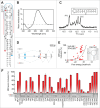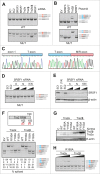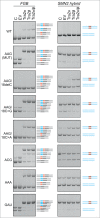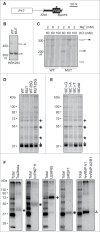The role of short RNA loops in recognition of a single-hairpin exon derived from a mammalian-wide interspersed repeat
- PMID: 25826413
- PMCID: PMC4615370
- DOI: 10.1080/15476286.2015.1017207
The role of short RNA loops in recognition of a single-hairpin exon derived from a mammalian-wide interspersed repeat
Abstract
Splice-site selection is controlled by secondary structure through sequestration or approximation of splicing signals in primary transcripts but the exact role of even the simplest and most prevalent structural motifs in exon recognition remains poorly understood. Here we took advantage of a single-hairpin exon that was activated in a mammalian-wide interspersed repeat (MIR) by a mutation stabilizing a terminal triloop, with splice sites positioned close to each other in a lower stem of the hairpin. We first show that the MIR exon inclusion in mRNA correlated inversely with hairpin stabilities. Employing a systematic manipulation of unpaired regions without altering splice-site configuration, we demonstrate a high correlation between exon inclusion of terminal tri- and tetraloop mutants and matching tri-/tetramers in splicing silencers/enhancers. Loop-specific exon inclusion levels and enhancer/silencer associations were preserved across primate cell lines, in 4 hybrid transcripts and also in the context of a distinct stem, but only if its loop-closing base pairs were shared with the MIR hairpin. Unlike terminal loops, splicing activities of internal loop mutants were predicted by their intramolecular Watson-Crick interactions with the antiparallel strand of the MIR hairpin rather than by frequencies of corresponding trinucleotides in splicing silencers/enhancers. We also show that splicing outcome of oligonucleotides targeting the MIR exon depend on the identity of the triloop adjacent to their antisense target. Finally, we identify proteins regulating MIR exon recognition and reveal a distinct requirement of adjacent exons for C-terminal extensions of Tra2α and Tra2β RNA recognition motifs.
Keywords: ESE, exonic splicing enhancer, ESS, exonic splicing silencer.; FGB, gene for fibrinogen; MIR, mammalian-wide interspersed repeat; SINE, Short INterspersed Element; SSO, splice-switching oligonucleotides; TE, transposable element; bulge; exon; hairpin; mutation; splicing enhancers and silencers; tetraloop; transposable elements; triloop.
Figures








Similar articles
-
Transposon clusters as substrates for aberrant splice-site activation.RNA Biol. 2021 Mar;18(3):354-367. doi: 10.1080/15476286.2020.1805909. Epub 2020 Sep 23. RNA Biol. 2021. PMID: 32965162 Free PMC article.
-
RNA Secondary Structure-Based Design of Antisense Peptide Nucleic Acids for Modulating Disease-Associated Aberrant Tau Pre-mRNA Alternative Splicing.Molecules. 2019 Aug 20;24(16):3020. doi: 10.3390/molecules24163020. Molecules. 2019. PMID: 31434312 Free PMC article.
-
Splicing of designer exons reveals unexpected complexity in pre-mRNA splicing.RNA. 2009 Mar;15(3):367-76. doi: 10.1261/rna.1498509. Epub 2009 Jan 20. RNA. 2009. PMID: 19155327 Free PMC article.
-
Exonization of transposed elements: A challenge and opportunity for evolution.Biochimie. 2011 Nov;93(11):1928-34. doi: 10.1016/j.biochi.2011.07.014. Epub 2011 Jul 26. Biochimie. 2011. PMID: 21787833 Review.
-
Regulation of alternative RNA splicing by exon definition and exon sequences in viral and mammalian gene expression.J Biomed Sci. 2004 May-Jun;11(3):278-94. doi: 10.1007/BF02254432. J Biomed Sci. 2004. PMID: 15067211 Free PMC article. Review.
Cited by
-
Transposon clusters as substrates for aberrant splice-site activation.RNA Biol. 2021 Mar;18(3):354-367. doi: 10.1080/15476286.2020.1805909. Epub 2020 Sep 23. RNA Biol. 2021. PMID: 32965162 Free PMC article.
-
Alternative splicing of U2AF1 reveals a shared repression mechanism for duplicated exons.Nucleic Acids Res. 2017 Jan 9;45(1):417-434. doi: 10.1093/nar/gkw733. Epub 2016 Aug 26. Nucleic Acids Res. 2017. PMID: 27566151 Free PMC article.
-
Intrinsic Regulatory Role of RNA Structural Arrangement in Alternative Splicing Control.Int J Mol Sci. 2020 Jul 21;21(14):5161. doi: 10.3390/ijms21145161. Int J Mol Sci. 2020. PMID: 32708277 Free PMC article. Review.
-
PUF60-activated exons uncover altered 3' splice-site selection by germline missense mutations in a single RRM.Nucleic Acids Res. 2018 Jul 6;46(12):6166-6187. doi: 10.1093/nar/gky389. Nucleic Acids Res. 2018. PMID: 29788428 Free PMC article.
-
Exon-centric regulation of ATM expression is population-dependent and amenable to antisense modification by pseudoexon targeting.Sci Rep. 2016 Jan 6;6:18741. doi: 10.1038/srep18741. Sci Rep. 2016. PMID: 26732650 Free PMC article.
References
-
- Wahl MC, Will CL, Luhrmann R. The spliceosome: design principles of a dynamic RNP machine. Cell 2009; 136:701-18; PMID:19239890; http://dx.doi.org/10.1016/j.cell.2009.02.009 - DOI - PubMed
-
- Burge CB, Tuschl T, Sharp PA. Splicing of precursors to mRNAs by the spliceosome. In: Gesteland RF, Cech TR, F. AJ, eds. The RNA World. New York: Cold Spring Harbor Laboratory Press, 1999:525-60.
-
- Fairbrother WG, Chasin LA. Human genomic sequences that inhibit splicing. Mol Cell Biol 2000; 20:6816-25; PMID:10958678; http://dx.doi.org/10.1128/MCB.20.18.6816-6825.2000 - DOI - PMC - PubMed
-
- Fairbrother WG, Yeh RF, Sharp PA, Burge CB. Predictive identification of exonic splicing enhancers in human genes. Science 2002; 297:1007-13; PMID:12114529; http://dx.doi.org/10.1126/science.1073774 - DOI - PubMed
-
- Wang Z, Rolish ME, Yeo G, Tung V, Mawson M, Burge CB. Systematic identification and analysis of exonic splicing silencers. Cell 2004; 119:831-45; PMID:15607979; http://dx.doi.org/10.1016/j.cell.2004.11.010 - DOI - PubMed
Publication types
MeSH terms
Substances
LinkOut - more resources
Full Text Sources
Other Literature Sources
Miscellaneous
